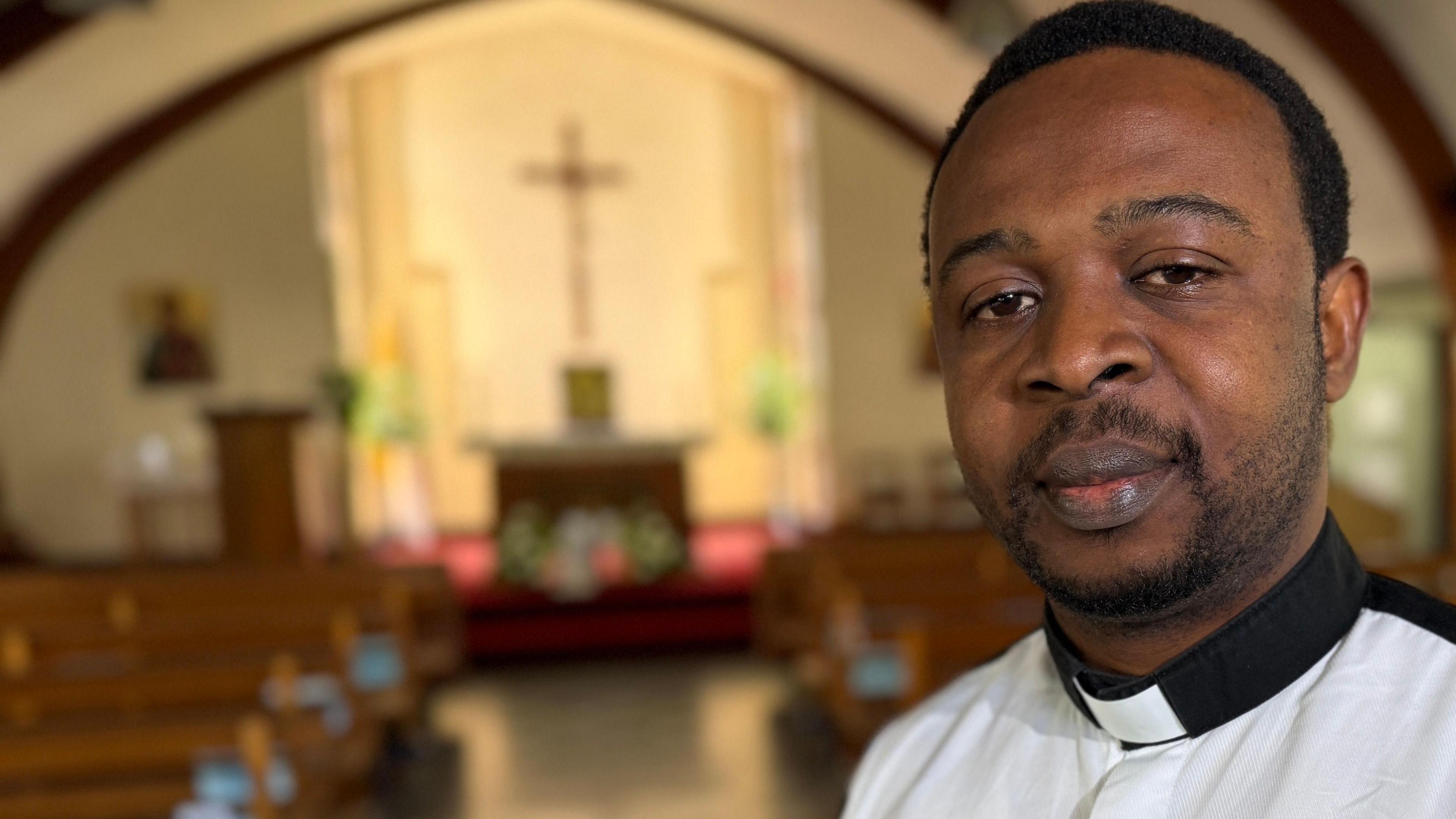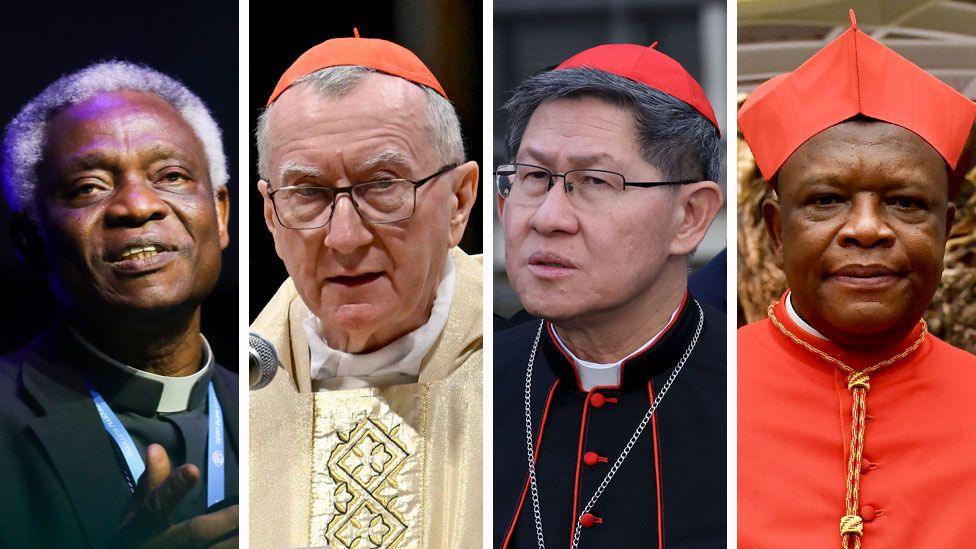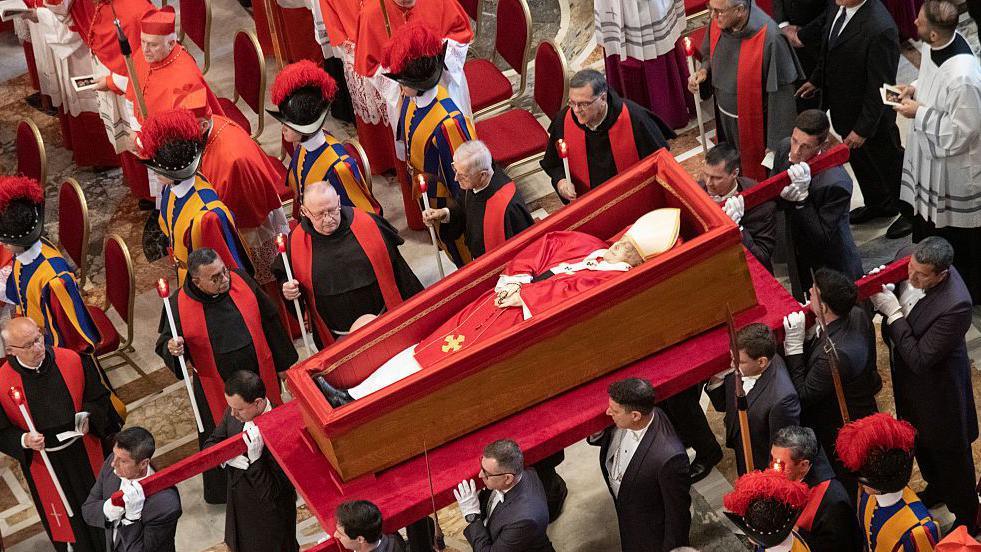The British Pope most people have never heard of
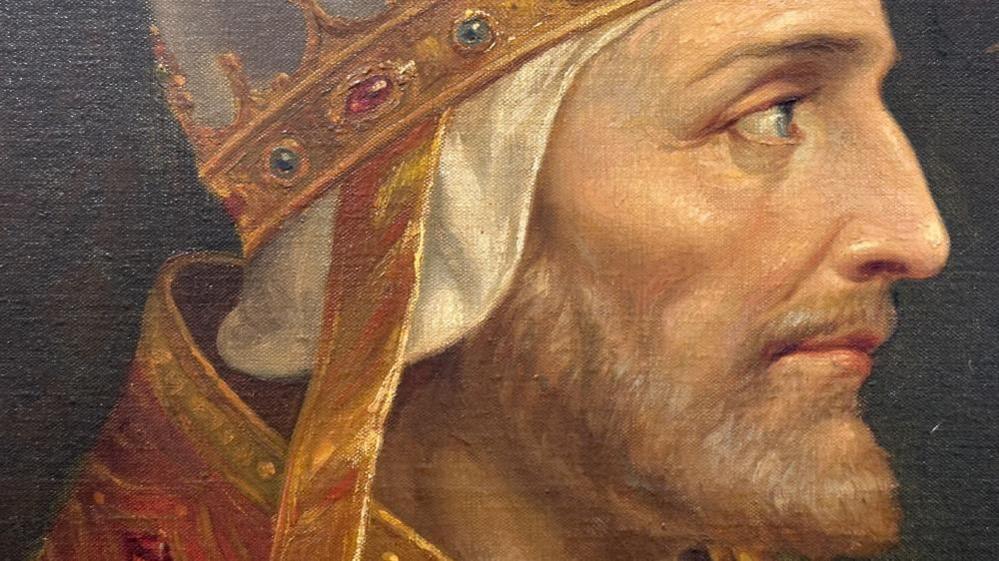
Pope Adrian IV became the 170th Pope in 1154, reigning until his death in 1159
- Published
Tens of thousands of people have descended on Vatican City to pay their respects to Pope Francis, whose funeral will be held this Saturday.
But despite the global focus on events in Rome, few realise that England once produced a Pope.
Nicholas Breakspear reigned in the mid‑12th Century, taking the name Pope Adrian IV, and is still the only Briton to hold the position.
Despite his remarkable journey from humble beginnings in Bedmond, Hertfordshire, to its highest office, his story remains one of the Catholic Church's most extraordinary - and least known.
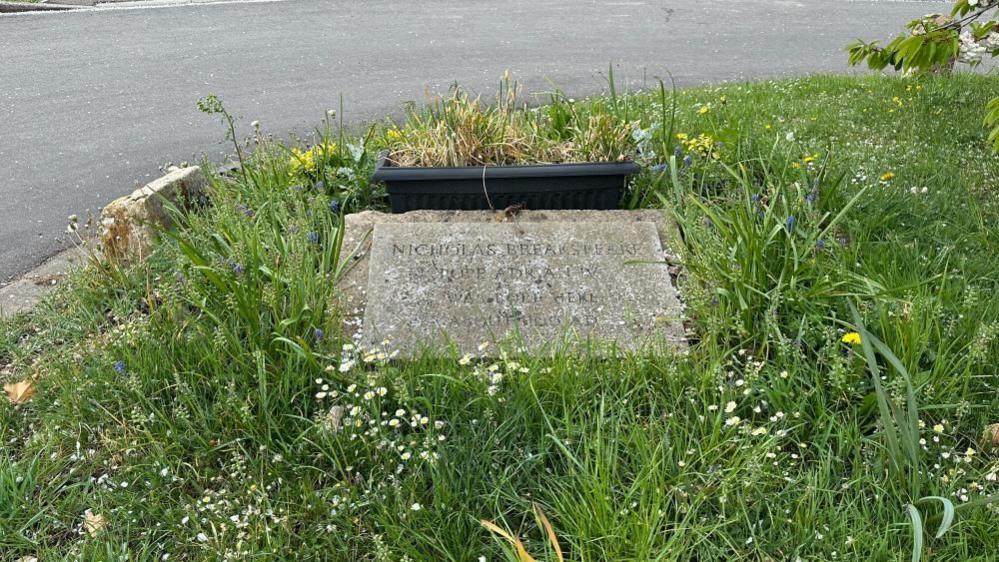
A commemorative plaque in Bedmond marks Pope Adrian IV's birthplace
"Breakspear was a young, impoverished lad from England, with no family connections, no money, and it was quite remarkable that he ended up as Pope by the time he was 50," explains his biographer, Adrian Waddingham.
Breakspear's start in life was anything but remarkable, however.
He was born around 1100 in Bedmond, in the parish of Abbots Langley, near Watford, the son of a minor cleric at St Albans Abbey.
There is some debate as to whether or not Breakspear's father was married, leading some to believe the future Pope may have been illegitimate.
Breakspear sought to follow in his father's footsteps and enter the abbey, but was refused, perhaps because of his lack of education.
Undeterred, he went to France to study before joining a monastery where he advanced to become an abbot.
Who is going to the Pope's funeral?
- Published26 April
Choosing the Pope: 'The conclave is intimidating'
- Published24 April
Who's most likely to replace Pope Francis?
- Published23 April
According to Waddingham, a large focus of Breakspear's work prior to becoming Pope took place in Scandinavia, where he created the first ever Archdiocese of Norway, giving it independence from the church in Germany.
"He is very well remembered in Norway - probably better remembered there than he is here," he says.
When he returned from Scandinavia in 1154, Breakspear became the 170th Pope following the death of Pope Eugenius III, remaining in the post until his death in 1159.
Such was his close association with Norway, the Royal Norwegian Society of Sciences and Letters placed an inscribed plaque next to his tomb in St Peter's Basilica.
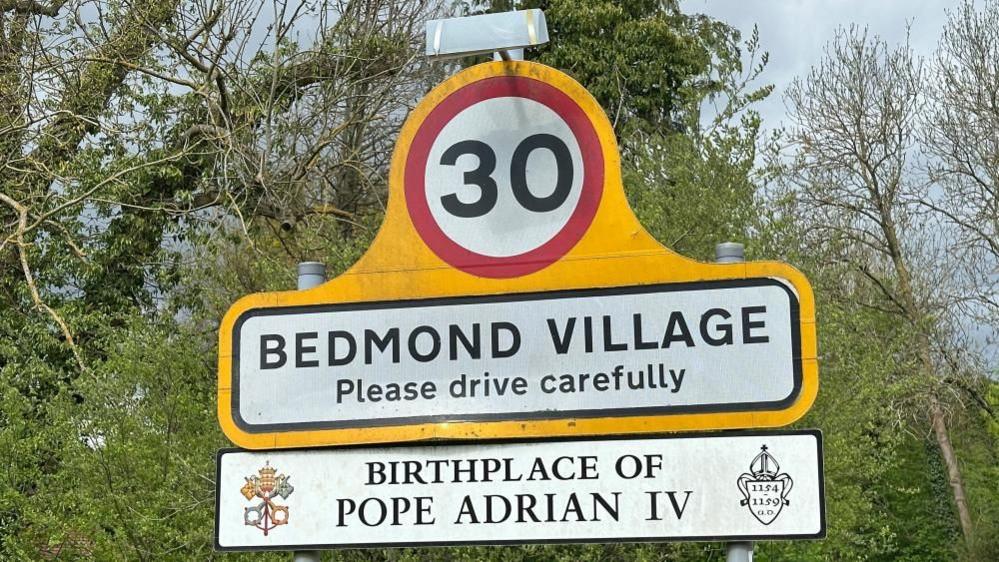
There are hints in and around Bedmond and Abbots Langley of the papal link
In and around Abbots Langley, there are subtle reminders about its distinguished former resident. Streets such as Popes Road, Adrian Road, and Breakspear Road all pay tribute, as does a secondary school in nearby St Albans.
"Our school is named after a man who proved that no dream is too great; no origin too small," says Declan Linnane, head teacher of Nicholas Breakspear Catholic School.
"Although as a school we continue to promote the values of Nicholas Breakspear, it would be great to see more done nationally to recognise and celebrate the life of England's only Pope."
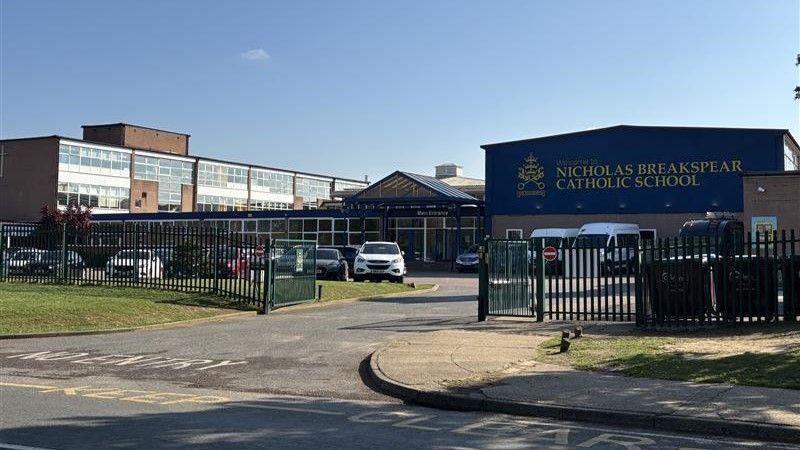
Nicholas Breakspear Catholic School in St Albans is named after the only English Pope
Each year, students and staff make a pilgrimage to Rome to visit his tomb.
"His story of faith, perseverance, and leadership is one that still speaks powerfully to young people today," says Mr Linnane.
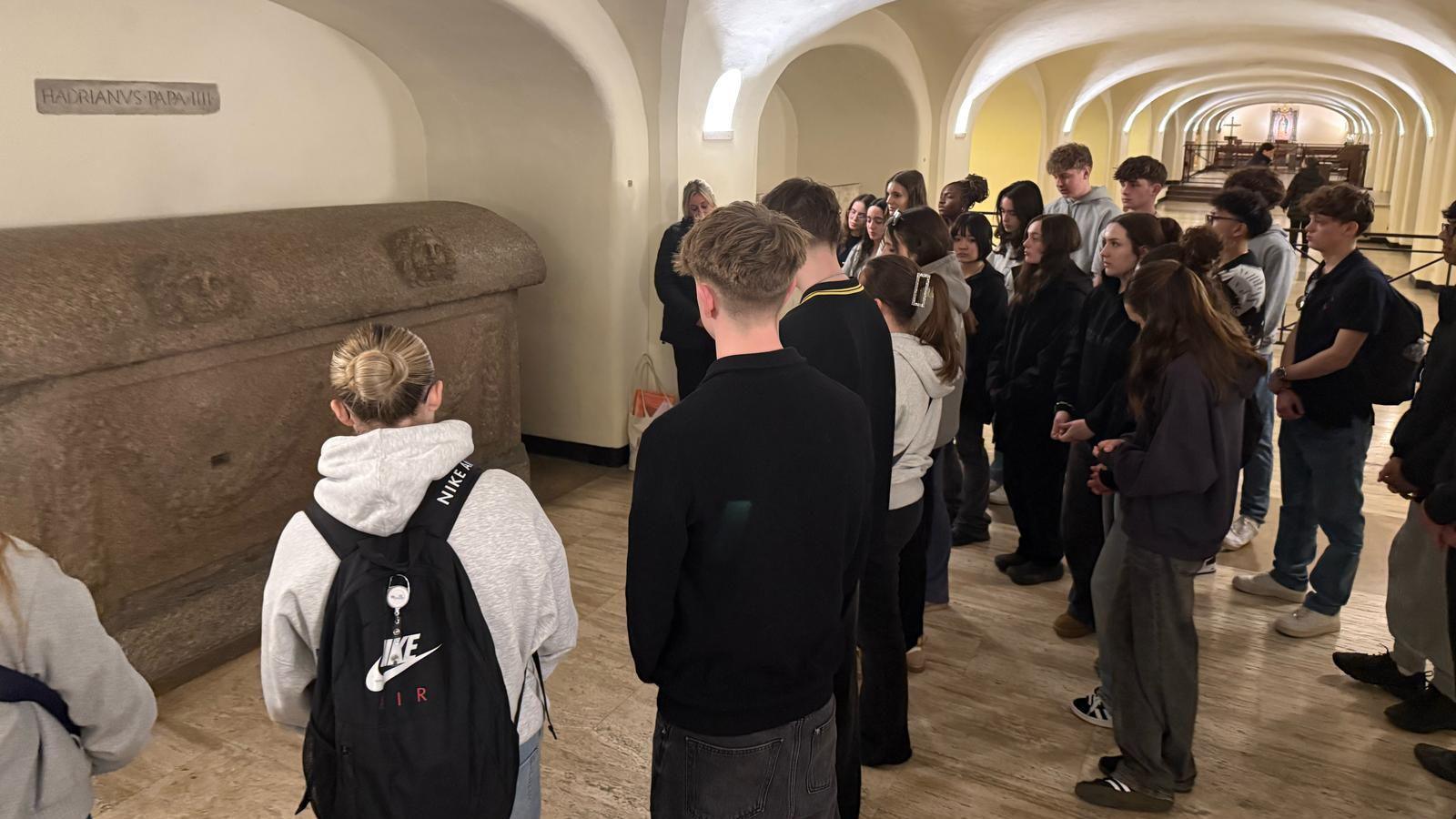
The school's students make an annual pilgrimage to the tomb of Pope Adrian IV in Rome
However, some feel the only English Pope is not celebrated as much as he ought to be.
Father Richard Mway is parish priest at St Saviour's in Abbots Langley, whose Catholic church has a stone bust and portrait of Breakspear in a small caged porch by its entrance.
Beyond that, though, there is nothing, he says. "We don't have a little museum or something... we could have a little bit more for people to learn.
"Even nationally, we don't talk about [him] much."
Waddingham, who wrote Breakspear: The English Pope Who Went to War, agrees.
"He is ignored. You will not find anywhere in our capital city - even in Westminster Cathedral - a monument or statue to the only English Pope. He is not remembered," he says.
In Bedmond, a small stone plaque, flanked by a plastic black flowerpot beside the main road, marks the birthplace of arguably Hertfordshire's most famous son.
Only if you were told it was there would you notice it, says Fr Mway.
Trevor Baker, treasurer of Abbots Langley Local History Society, admits more could be done with the "modest and unworthy" plaque.
"A more substantial memorial has been suggested from time to time; however, funding, maintaining and resourcing [a] suggested museum would be a huge commitment," he says.

Fr Richard Mway believes Pope Adrian IV should be widely celebrated as a great leader
Fr Mway says he tries his best to keep the memory of Breakspear alive, but admits even some members of his own congregation may have no idea of the parish's historical relevance to Rome.
"I would say 60% may know who he is," he says.
So, why has history quietly forgotten Nicholas Breakspear? The answer may be found in the period he reigned.
"He chose a bad time to be Pope," says Waddingham.
"In 1154, he was threatened on three sides by powerful forces: Frederick Barbarossa in the North; King William of Sicily in the south; and, if that weren't enough, the Byzantine emperor was trying to re-establish his territories on the Adriatic coast of Italy," he explains.
The author believes the history of the time is dominated by the Holy Roman Emperor Barbarossa, "which is perhaps why we know so little about Adrian - he was belittled by the German historians".
This sentiment was captured centuries ago by historian Edward Gibbon, best known for his History of the Decline and Fall of the Roman Empire, published 1776-89:
"The English reader may consult the Biographia Britannica, ADRIAN IV., but our own writers have added nothing to the fame or merits of their countryman," he lamented.
Yet Breakspear's life story is inspiring to those who know of him, especially those who worship in the church most commonly associated with him.
A tablet commemorating Breakspear is proudly displayed on the wall of the Church of St Lawrence the Martyr in Abbots Langley.
Churchwarden Dr Thomas Betteridge says he should be more widely celebrated.
"He transcended the limitations of class and education in a deeply hierarchical culture in order to become Pope. That, in itself, should warrant more importance being placed on his life story," he says.
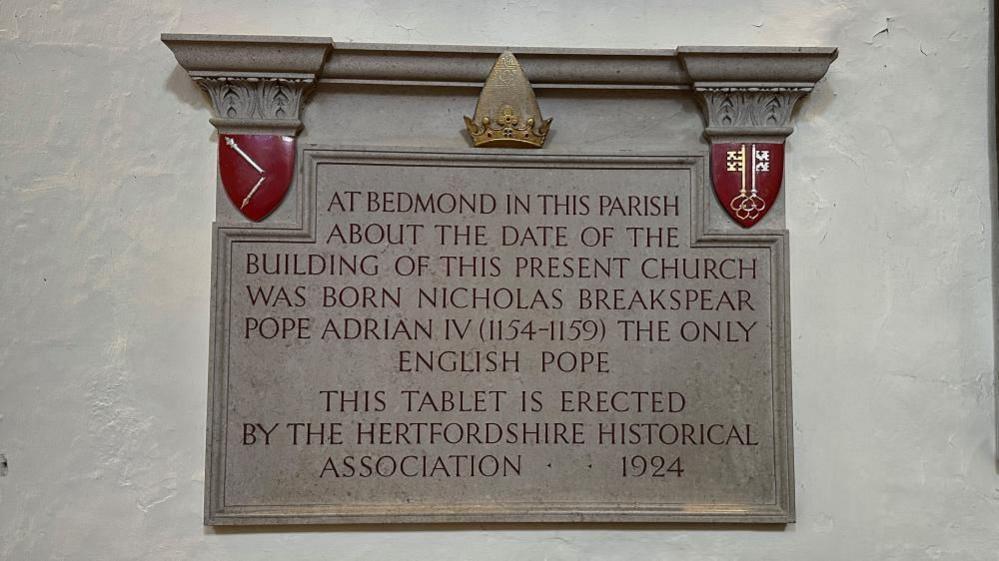
England's only Pope was born Nicholas Breakspear in about 1100 in Bedmond
White smoke, announcing the election of a new pontiff, may not billow above the Sistine Chapel for several days yet.
And while the identity of Pope Francis's successor remains uncertain, one outcome is almost assured: the next Pope is highly unlikely to be English.
The College of Cardinals, external presently includes four Britons (Vincent Nichols, Michael Fitzgerald, Arthur Roche and Timothy Radcliffe), three of whom are young enough to cast a vote in the conclave.

White smoke from a chimney on the roof of the Sistine Chapel will indicate that a new Pope has been chosen
None is regarded as a frontrunner for the papacy, yet history shows that unexpected choices can and do emerge from the conclave's closed doors.
"Well, anything is possible – and we know from recent conclaves that favourites don't seem to be elected," explains Waddingham.
"Even if we were to get an English Pope, it's unlikely he would be elected unanimously on the first ballot, which was a remarkable achievement of Nicholas Breakspear in 1154."
Fr Mway says: "I pray just to have another good Pope, another good Father and another good pastor to help us to pray to strengthen our relationship with Jesus.
"I don't mind the country, personally."
Get in touch
Do you have a story suggestion for Beds, Herts & Bucks?
Follow Beds, Herts and Bucks news on BBC Sounds, Facebook, external, Instagram, external and X, external.
Related topics
- Published23 April
